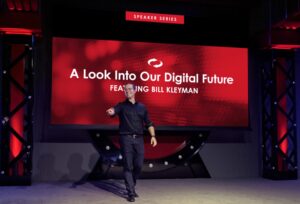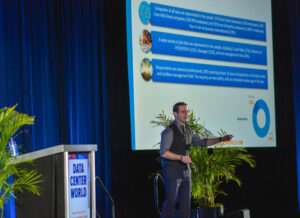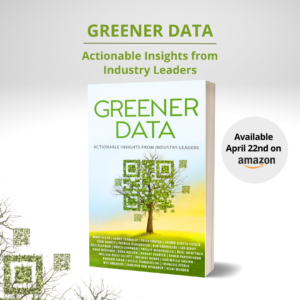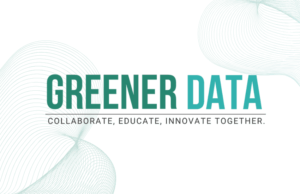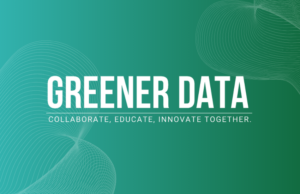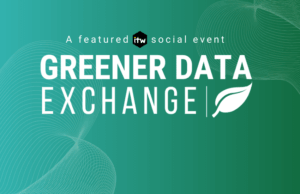Bill Kleyman, Executive Vice President of Digital Solutions with Switch Data Centers, and a contributing editor with Data Center Knowledge, Data Center Frontier, AFCOM and Data Center World Program Chair.
Bill is also a contributing author to the much-anticipated book Greener Data: Actionable Insights from Industry Leaders, making its debut on Amazon on Earth Day – April 22, 2022.
Q. What does the term Greener Data mean to you?
Data is the lifeblood of our modern society. Nearly everything we do today revolves around some type of data stream. From the moment we wake up to the moment we go to bed, our movements, steps, sleep patterns, and much more are documented, stored, correlated, and presented to us in a manner we can understand.
In the business world, data delivers powerful transformative solutions aimed at keeping businesses agile and competitive in a connected economy.
However, every click we make and every step we take that’s digitally recorded has an impact on our world. Those outside of the technology realm take connectivity and data-driven platforms as given pieces of our everyday lives. For those that understand the direct impacts of every 1 and 0, we know that data has a very real and tangible presence in our lives.
To me, Greener Data is the holistic approach to understanding our impact on this planet. It is the understanding that every Google search can power a 100w light bulb for 11 seconds. It’s knowing that digital waste equals physical waste. A greener planet requires greener data to create a greener future.
My hope is that Greener Data in the very near future means that we support emerging technologies like AR, VR, the metaverse, and the immersive Internet with a carbon-neutral footprint. More so, Greener Data aims to reverse the impacts of previous technology advancements to help support carbon-negative approaches to digital solutions.
Q. What led you to your career in technology? Did you have any mentors along the way?
I can honestly say that I’ve always been fascinated by technology. As a kid growing up in Kyiv, Ukraine, I had the chance to see my brother compete in nationwide communications competitions. What was his tool to communicate? The telegraph. No… I’m not kidding. He had the headphones, the telegraph switch, and the know-how to be one of the best in the USSR. He would let me sit on his lap and do Morse code with people all over Ukraine and the USSR.
Since that moment, I was fascinated by the concept of connecting people over vast distances.
When we came to the USA, I would say I was pretty fortunate in being able to jump into the technology space to learn about programming, infrastructure design, and so much more. Early in my career, I met Rich Miller. At the time, he was the Editor-in-Chief of the Data Center Knowledge online news site and journal. I had the chance to learn about writing, creating a voice in the industry, and how to follow some of the most advanced solutions in the data center space.
Other than Rich, I’ve had numerous individuals take m under their wing. Prior to joining Switch I worked with many great leaders that let this millennial learn the ropes of the business and how technology applied to their organization. Sean McCarthy from World Wide Fittings allowed me to lead a technology effort to modernize his organization. It was a wonderful experience. Later on, Steve Stringer, the CEO of MTM Technologies taught me how to be a better leader and executive. I remember I would sit in on meetings and just soak in the conversions. I’m sure I’m leaving a few names out. I apologize for that if anyone is reading this and gets upset. I’m very fortunate to have had several brilliant leaders in my life.
Q. At what point in your career did you realize that our planet was being impacted and needed more sustainable solutions for digital infrastructure?
The biggest realization came when I started working at my current role at Switch. Knowing just how much we care about the environment and all that we do to ensure we bring green designs into the world makes Switch a wonderful place to be. However, I also saw how the industry was being painted in mainstream media and among people who didn’t really know what we do. Or, they simply had no idea what a data center looked like.
It was at this point that I felt we needed to not only educate the rest of the world on the importance of digital infrastructure. But we also needed to show them how we are making our designs as green as possible. New innovations around solar and battery solutions, tidal turbines, floating solar panels, and even nuclear-powered data centers are all a reality in our industry.
With every click you make, there is a physical impact. While we do our best to ensure that we build greener data centers, people need to know how to not create digital waste. As part of this effort, working with new solutions aimed at protecting the environment, water sources, power solutions, and much more became a key priority. Through our work at Switch, we are trying to lessen the impact of data to create a greener planet.
Q. What are some of the ways you believe we can power the future of data centers through innovation?
This is probably my favorite question… We get the chance to look ahead and become inspired by some of the solutions being created.
When it comes to fossil fuels, there’s already a milestone that we’ve reached that very few people know about. Greener sources have gained market share in the U.S. and Europe, aided by government subsidies and other policies to reduce the use of coal, the dirtiest fossil fuel. In 2019, before the onset of the pandemic, the U.S. consumed more renewable energy than coal for the first time since 1885.
I wrote an article about this and I do discuss this in my chapter. Today, leaders are creating green technologies that will drive a more sustainable digital future. Here are some creative examples to get excited about:
- Dominion Energy’s Coastal Virginia Offshore Wind Project. In July, Dominion Energy announced an extraordinary project. The proposed 2.6-gigawatt Coastal Virginia Offshore Wind (CVOW) commercial project will be the largest planned offshore wind farm in the United States. “I’m thrilled to see this project underway as it’s an exciting step toward a clean energy economy that creates good jobs in the Commonwealth,” said U.S. Senator Tim Kaine (D-VA). “I will keep pushing for clean energy investments in Virginia to boost our economy and build a more sustainable future.”
- Japan: The World Leader in Floating Solar Panels. A recent post from the World Economic Forum puts it best … How do you increase your solar energy output when you need all your land for agriculture and housing? Take to the water. The world’s first floating solar plant was built in Japan, in Aichi Prefecture in central Honshu. The country’s many inland lakes and reservoirs are now home to 73 of the world’s 100 largest floating solar plants and account for half of those plants’ 246 megawatts of solar capacity. The biggest Japanese floating solar plant sits behind the Yamakura Dam at Ichihara in Chiba Prefecture. It covers 18 hectares, can power nearly 5,000 homes, and saves more than 8,000 tonnes of CO2 a year.
- Microsoft’s Data Center Beneath the Sea. Microsoft’s Project Natick team deployed the Northern Isles datacenter 117 feet deep to the seafloor in spring 2018. For the next couple of years, the team of researchers and technologists actively monitored, tested, and began to understand better the data center’s servers’ performance and reliability, but underwater.
The idea with this submerged infrastructure was that a sealed container on the ocean floor could improve data centers’ overall reliability. After pulling the system out, what did Microsoft learn? Underwater data centers can be very practical, highly reliable, exceedingly energy-efficient and sustainable. Leveraging 100% locally produced renewable electricity from on-shore wind and solar, offshore tide, and wave, Microsoft found that the servers in Natick Northern Isles showed a failure rate of 1/8th that of our land-based control group. Further, the planned length of operation without maintenance is five years.
“We are populating the globe with edge devices, large and small,” said William Chappell, vice president of mission systems for Azure. “To learn how to make data centers reliable enough not to need human touch is a dream of ours.”
- The Power of the Tidal Turbine. This one is super exciting. A tidal turbine weighing 680 metric tons and dubbed “the world’s most powerful” has started grid-connected power generation at the European Marine Energy Centre in Orkney, an archipelago located north of mainland Scotland. In a recent announcement, Scottish engineering firm Orbital Marine Power explained how its 2-megawatt O2 turbine had been anchored in a body of water called the Fall of Warness, with a subsea cable linking it to a local electricity network on land. It’s expected that the turbine, which is 74 meters long, will “operate in the waters off Orkney for the next 15 years,” the company said, and have “the capacity to meet the annual electricity demand of around 2,000 UK homes.”
- The Nuclear-Power Data Center. A recent DCD post discusses how Rolls-Royce plans to offer small nuclear reactors to US-based cloud operators so their hyperscale data centers can have net-zero emissions and be independent of the electric grid. Small modular reactors (SMRs) are under development by a consortium led by Rolls-Royce. They could potentially power data centers or other infrastructure that needs a steady low-carbon energy supply, which may not be available from the local electricity grid.
Q. What are some of the ways you, along with Switch, have impacted the digital infrastructure industry in sustainability?
To create a greener future, there must be leaders who will undertake green initiatives. This is the really special part of working at a place like Switch. We continuously have ongoing projects aimed at creating greener digital infrastructure, and in turn, greener data. Here are two really cool examples of what Switch is doing to create a more sustainable future:
- Switch’s Regional Water Improvement Pipeline Project. There’s a lot of sunshine in Nevada, but not a lot of water. Governor Steve Sisolak joined leaders from every local government in the Truckee River region to celebrate the commencement of the construction of the Regional Water Improvement Pipeline Project. The sixteen-mile pipeline will deliver 4,000 acre-feet of treated effluent water from Truckee Meadows Water Reclamation Facility (TMWRF) in Sparks to the Tahoe Reno Industrial Center (TRI Center). The project led by TRI Center and Switch is the first regional public-private partnership in Nevada history to engage the support of each municipality and agency in Northern Nevada. Partners include the State of Nevada, City of Reno, City of Sparks, Washoe County, Storey County and Truckee Meadows Water Authority, and several prominent private sector partners such as the Master Developer of TRI Center Switch and other leading technology companies. Farr West Engineering is the construction manager for the project. Switch operates a 1.3 million square foot data center at the Citadel campus. The company intends to build up to 7.2 million square feet of IT capacity and a total power capacity of 650 megawatts. The pipeline will support all of the water requirements at the campus when it is completed in the first quarter of 2023.
- Switch Gigawatt 1: The World’s Largest Behind-the-meter Solar Project. Switch, and Capital Dynamics announced three ground-breakings in Nevada, which, along with an earlier phase, will continue Switch Founder and CEO Rob Roy’s Gigawatt Nevada solar energy and battery vision to develop one of the largest solar footprint and battery storage projects in the technology industry. With these new ground-breakings in Clark and Storey counties, plus the original Townsite development, Gigawatt 1 will soon generate a total of 555 MW of solar power using the latest First Solar panels and create 800 MW hours of battery storage leveraging Tesla Megapack technologies. Additionally, the Storey County location will be the largest behind-the-meter solar project globally, producing 127MW and including a 240 MW hour battery storage system. Behind-the-meter projects generate power off the public grid, placing no burden on legacy public utility production.
Q. You have a chapter you authored in Greener Data: Actionable Insights from Industry Leaders, entitled “Defining the Digital Infrastructure Industry”, due out on Amazon on Earth Day, April 22. What was one of the main reasons you decided to be a part of the book and how do you plan to utilize the opportunity to spread the word to others?
I’m a millennial and I have a very young daughter. I’m doing this for her. Her generation is already a digital generation born with a digital footprint.
The other important factor here is that we are already doing some amazing things to ensure we have a greener future. The private sector is investing billions of dollars to support green initiatives to ensure every click you make is a green one. With this book and my chapter, I plan to help people understand what a green infrastructure looks like and how we’re already doing amazingly innovative things to support sustainability.
Click here to listen to Bill talk about sustainability in digital infrastructure and more in a special Greener Data episode of JSA’s Data Movers podcast.
Follow the Greener Data movement on LinkedIn with the hashtag #GreenerData.






